
Fraxinus americana, the white ash or American ash, is a fast-growing species of ash tree native to eastern and central North America.
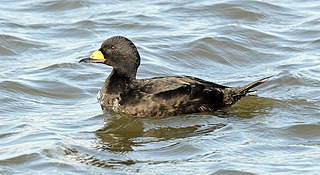
The black scoter or American scoter is a large sea duck, 43 to 49 cm in length. The genus name is derived from Ancient Greek melas "black" and netta "duck". The species name is from the Latin for "American".

Agave americana, commonly known as the century plant, maguey, or American aloe, is a flowering plant species belonging to the family Asparagaceae. It is native to Mexico and the United States, specifically Texas. This plant is widely cultivated worldwide for its ornamental value and has become naturalized in various regions, including Southern California, the West Indies, South America, the Mediterranean Basin, Africa, the Canary Islands, India, China, Thailand, and Australia.
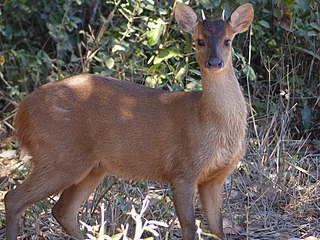
The red brocket is a species of brocket deer from forests in South America, ranging from northern Argentina to Colombia and the Guianas. It also occurs on the Caribbean island of Trinidad.

Tilia americana is a species of tree in the family Malvaceae, native to eastern North America, from southeast Manitoba east to New Brunswick, southwest to northeast Oklahoma, southeast to South Carolina, and west along the Niobrara River to Cherry County, Nebraska. It is the sole representative of its genus in the Western Hemisphere, assuming T. caroliniana is treated as a subspecies or local ecotype of T. americana. Common names include American basswood and American linden.

Conopholis americana, the American cancer-root, bumeh or bear corn, is a perennial, non-photosynthesizing parasitic plant. It is from the family Orobanchaceae and more recently from the genus Conopholis but also listed as Orobanche, native but not endemic to North America. When blooming, it resembles a pine cone or cob of corn growing from the roots of mostly oak and beech trees.

The American Elm cultivar Ulmus americana 'Moline' was cloned from a wild seedling transplanted to Moline, Illinois, from nearby Rock River Valley in 1903 and propagated from 1916 by the Klehm Nurseries, Arlington Heights, Illinois.

The American elm cultivar Ulmus americana 'Aurea' was cloned from a tree discovered by F. L. Temple in Vermont at the end of the 19th century.
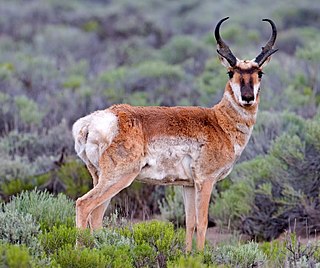
The pronghorn is a species of artiodactyl mammal indigenous to interior western and central North America. Though not an antelope, it is known colloquially in North America as the American antelope, prong buck, pronghorn antelope and prairie antelope, because it closely resembles the antelopes of the Old World and fills a similar ecological niche due to parallel evolution. It is the only surviving member of the family Antilocapridae.

Hulettia is an extinct genus of ray-finned fish known from United States. This fish genus contains two species, H. americana and H. hawesi.
The American Elm cultivar Ulmus americana 'Miller Park' is a selection made by the University of Minnesota. Originally identified as MNT-0365, it was cloned from an old elm surviving in Hennepin County, Minnesota. 'Miller Park' is currently being researched (2016), but no data has yet been published. The tree is named for the eponymous park in Eden Prairie, in the environs of Minneapolis.
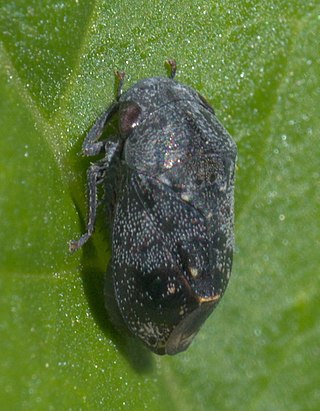
Penthimia americana is a species of leafhopper in the family Cicadellidae.

Lepidanthrax is a genus of bee flies in the family Bombyliidae. There are at least 50 described species in Lepidanthrax.
Leptopteromyia is a genus of robber flies in the family Asilidae. There are about seven described species in Leptopteromyia.
Pholcophora americana is a species of cellar spider in the family Pholcidae. It is found in the United States and Canada.
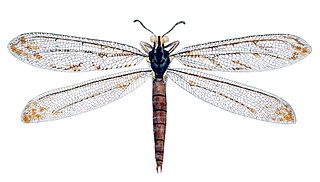
Vella is a genus of antlions in the family Myrmeleontidae. There are about five described species in Vella.
Phratora americana is a species of leaf beetle in the family Chrysomelidae. It is found in North America.This species is known from Ontario, Quebec, and high elevations in the eastern United States of America. It feeds on willow species and varies in color from purple to blue or blue-green.
Phyllodromia americana is a species of dance flies in the family Empididae.
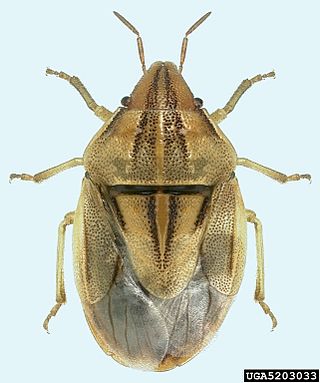
Aelia americana is a species of stink bug in the family Pentatomidae. It is found in North America.

The Pacific marten is a species of North American mammal, a member of the family Mustelidae. It is found throughout western North America.















